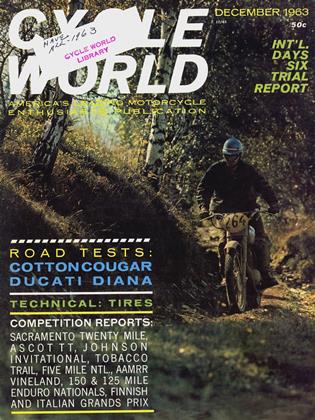ITALIAN GRAND PRIX
CARLO PERELLI
THE 41ST ITALIAN Grand Prix (or more exactly, the Gran Premio delle Nazioni, or National GP, as it has always been called by the organizers), held as usual over the fast and famous Monza circuit, was run in fine weather. Over 50,000 racing fans had the pleasure of seeing a clear victory by Provini on the Morini over Redman’s Honda in the 250cc class, thus raising hopes that a world title could be brought back to Italy. Since 1960 no Italian rider has been crowned a world champion; the honor last went to Ubbiali.
In the 125cc class there were no Suzukis on the starting line since this meet did not include a 50cc class, the category in which Suzuki is most interested and their battle with Kreidler is not yet finished, while the 125cc class title is already in their hands. Opposition to Honda in the 125cc class was expected from Spaggiari riding a private MV who established the best times in practice, and Italian champion Villa riding the new Mondial twostroke, with a rotary-valve, horizontal cylinder cooled by water and an air-cooled head. Villa set up considerable speed during practice but rather surprisingly the Mondial bosses decided not to race. Spaggiari, who had quite a good start, was halted in the first lap by a broken clutch.
So, it was quite easy for Redman and Taveri, both Honda mounted, to lead the race start to finish with the Swiss Taveri just beating his team mate. But, if there wasn’t a good fight for the lead positions, Takahashi (Honda), Grace (on a new experimental water-cooled Bultaco), Visenzi (Honda), Malina (CZ), and Torras (Bultaco), made up for it. No less than five riders from five different countries riding four different makes of machines!
Ramon Torras, the young Spaniard, well known for his hot riding style, was cranking his Bultaco over to an incredible degree of angle and was often using “speedway” riding techniques to avoid crashing in some of the bends. It couldn't last though as soon as he failed to recover in the “parabolic” bend from a slide and crashed at over 60 mph; he luckily escaped unhurt.
In the final stages, Takahashi and Visenzi drew away from Malina and Grace with Takahashi coming in third, while Grace, riding very fast on the conventional Bultaco dashed across the finish line a yard or so in front of the Czech Malina on his double-overhead cam CZ.
Provini crashed twice in practice for the 250cc event, riding his remarkable singlecylinder, dohc Morini, but he didn’t seem to suffer any from the experience in the race, as his riding style was neat and as supreme as ever. He had a new team mate, young Giacomo Agostini, an upand-coming production racer on a 175cc push-rod Morini. Derek Minter was a newcomer to the Benelli team, with Silvio Grassetti as team mate. Alan Shepherd was down with the water-cooled MZ two-strokes from East Germany, but unfortunately he was without factory assistance due to visa problems since East Germany is of course not a member of the NATO countries.
The Honda team counted on Redman and Robb with the four-cylinder models, and Taveri and Takahashi on the twins. During the first laps Redman was attacked furiously by Provini, Agostini and Shepherd, while the other Honda men were soon left behind and the Benelli riders could not even challenge the leaders, soon retiring with mechanical problems. Agostini retired with a loose exhaust pipe while showing fine riding style, and Shepherd lost a whole lap in a pit stop to change plugs. So Provini and Redman remained alone, and in the final stages the Italian champion managed to force his way to the front.
We must add though, the Hondas, minus works assistance, were not in their best condition, and in fact, both the lap and distance records set by Honda works riders in 1961 were not broken by a margin of over .6 mph. And this in spite of recent improvements to the surface of the track in the notorious Lesmo bends zone.
For the 350cc race, Redman had a “fresh” engine to do battle with the Italian Remo Venturi on the Bianchi twin and beat both the lap and distance records. Unlucky Venturi, riding well as usual, was forced to use a spare old-type machine since the new-type with lower frame and fairing developed trouble in the gear-box during warm up runs. Worse, Venturi had to stop to repair his gear change lever during the race so Shepherd on the 251cc two-stroke MZ twin could slip by and take second place.
In the 500cc class the Gilera opposition to the lone “private” MV of Hailwood soon faded away. Hartle crashed in practice at the famous “Curvone” (big bend) at 130 mph after finishing the finish straight and was lucky to be alive. So, Scuderia Duke only fielded Minter and Read whose practice times were slower than Hailwood. In the race only Minter could get into Hailwood’s slip stream, and then only for short periods.
Venturi, riding an overbored 450cc Bianchi twin, after a not-so-good start overtook Read and Minter, then Minter retired with suspension troubles while Read, plagued by an oil loss which gave his some exciting moments while limiting the showing of “Mint.” Venturi was again unlucky, retiring with valve trouble while lying in a comfortable second spot behind Hailwood. Young Mike Hailwood thus won at a record speed crowning with a marvelous ride the conqdest of the world 500cc title. •











